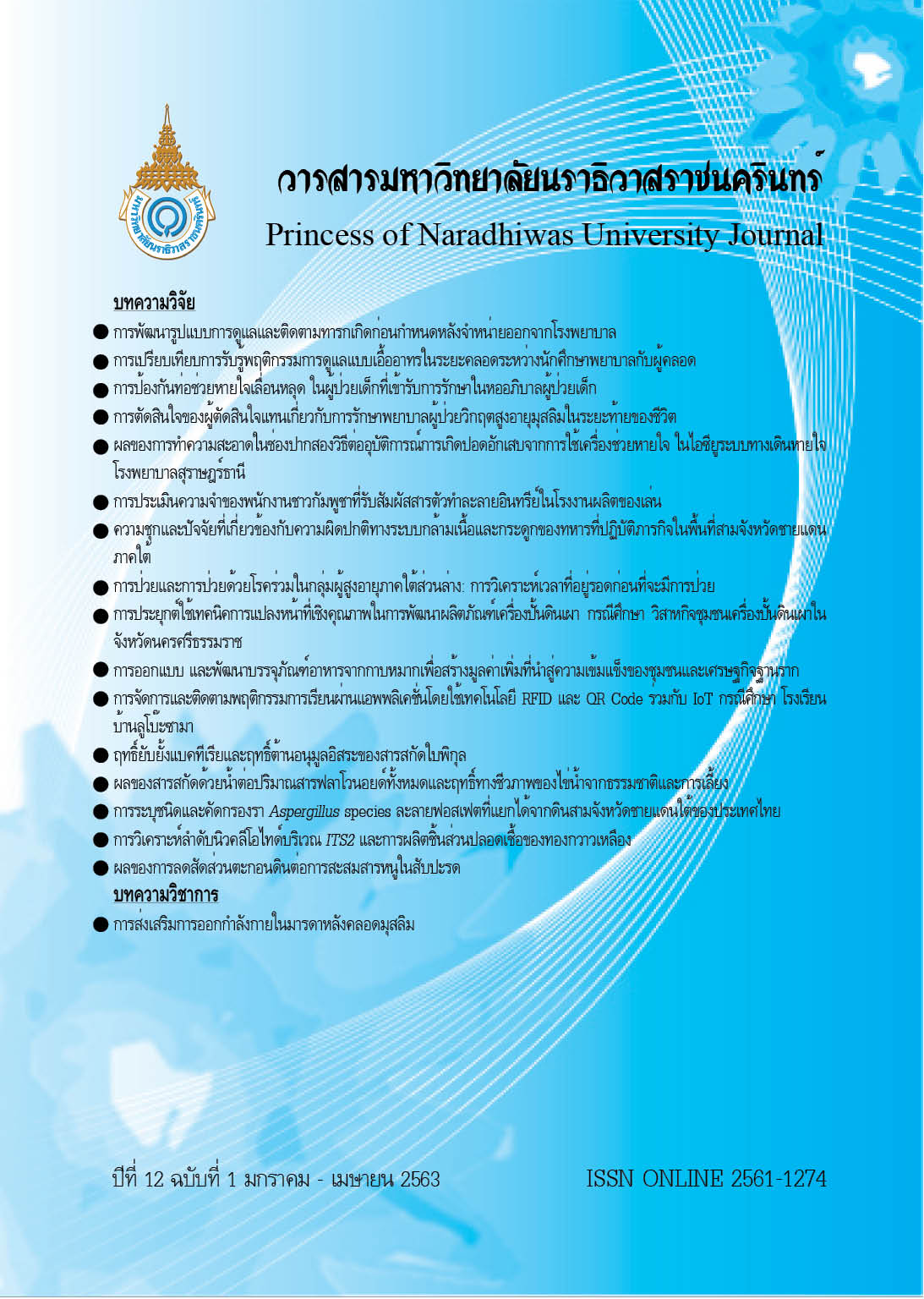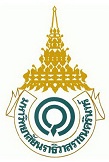Effect ผลของสารสกัดด้วยน้ำาต่อปริมาณสารฟลาโวนอยด์ทั้งหมดและฤทธิ์ทางชีวภาพ ของไข่น้ำาจากธรรมชาติและการเลี้ยง
คำสำคัญ:
ไข่น้ำ, สารฟลาโวนอยด์, สารต้านอนุมูลอิสระ, แอลฟากลูโคซิเดสบทคัดย่อ
การศึกษาครั้งนี้มีวัตถุประสงค์เพื่อเปรียบเทียบปริมาณสารฟลาโวนอยด์ทั้งหมดและฤทธิ์ทางชีวภาพของไข่น้ำาจากธรรมชาติและการเลี้ยง ซึ่งไข่น้ำาจากธรรมชาติได้เก็บตัวอย่างมาจากอำาเภอเขาชัยสน จังหวัดพัทลุง นำาไข่น้ำาจากธรรมชาติมาทำการเลี้ยงด้วยปุ๋ยมูลไก่เพื่อได้เป็นไข่น้ำาจากการเลี้ยงทำาการสกัดด้วยน้ำาที่สภาวะที่แตกต่างกัน (อุณหภูมิ/เวลา) 5 วิธีได้แก่ 4 ºC/24 h,
25 ºC/12 h, 50 ºC/6 h, 75 ºC/3 h และ 100 ºC/1.5 h หลังจากนั้นนำามาวิเคราะห์ปริมาณสารฟลาโวนอยด์ทั้งหมด และฤทธิ์
ทางชีวภาพในด้านการยับยั้งอนุมูลอิสระด้วยวิธี DPPH, ABTS และการยับยั้งแอลฟากลูโค-ซิเดสผลการศึกษาพบว่าไข่น้ำาจาก
ธรรมชาติและการเลี้ยงมีปริมาณสารฟลาโวนอยด์ทั้งหมดและฤทธิ์ทางชีวภาพแตกต่างกันทางสถิติ (p<0.05) โดยพบว่าปริมาณสาร
ฟลาโวนอยด์ทั้งหมดสูงที่สุดในสารสกัดไข่น้ำาจากธรรมชาติที่สกัดด้วยวิธี 100ºC/1.5 h (27.249±0.10 mg QE/g extract) ในส่วนของฤทธิ์ยับยั้ง DPPH radical และ ABTS radical พบว่าสารสกัดไข่น้ำาจากธรรมชาติที่สกัดด้วยวิธี 75º C/3 h สามารถยับยั้ง
ได้ดีที่สุดซึ่งมีค่า IC50 เท่ากับ 0.017±0.00 และ 0.016±0.00 mg/mL ตามลำาดับ ส่วนฤทธิ์ยับยั้งการทำางานของเอนไซม์มอล
เทสและซูเครส พบว่าสารสกัดไข่น้ำาจากธรรมชาติที่สกัดด้วยวิธี 100 ºC/1.5 h และ 4 ºC/24 h มีฤทธิ์ยับยั้งดีที่สุดมีค่า IC50
เท่ากับ 8.346±0.03 และ 1.723±0.02 mg/mL ตามลำาดับนอกจากนี้จากการวิเคราะห์ค่าสัมประสิทธิ์สหสัมพันธ์ระหว่างค่า IC
50ของฤทธิ์ทางชีวภาพและสารฟลาโวนอยด์ทั้งหมดพบว่าสารฟลาโวนอยด์มีส่วนสำาคัญในการยับยั้งแอลฟากลูโคซิเดสมากที่สุดทั้งนี้ผลที่ได้จากการศึกษาครั้งนี้แสดงให้เห็นอย่างชัดเจนว่าสารสกัดจากไข่น้ำามีศักยภาพที่จะพัฒนาเป็นสารต้านอนุมูลอิสระธรรมชาติและพัฒนาเป็นผลิตภัณฑ์เพื่อสุขภาพได้
References
Borges de Melo, E., Da Silveira Gomes, A. & Carvalho, I. (2006). α-and β-Glucosidase inhibitor: chemical structure and biological activity. Tetraedron, 62(44) , 10277-10302
Buddhakala, N., Talubmook, C., Posri, S. & Buatone, S. (2015). Effects of Ginger Extract in the Treatment of Diabetic Rats. RMUTP Research Journal Special Issue The 5th Rajamangala University of Technology National Conference, 302-311.
Chang, C., Yang, M., Wen, H. & Chern, J. (2002). Estimation of total flavonoid content in propolis by two complementary colorimetric methods. Journal of Food and Drug Analysis, 10, 178-182.
Damsud, T., Grace, M.H., Adisakwattana, S. & Phuwapraisirisan, P. (2014). Orthosiphol A from the aerial parts of Orthosiphonaristatus is putatively responsible for hypoglycemic effect via alpha-glucosidase inhibition. Natural Product Communication, 9, 639-641.
Damsud, T. & Kaewpiboon, C. (2016). In Vitro α-Glucosidase Inhibitory Activities of the Watercress (Nasturtium officinale R. Br.) Extracts. Phranakhon Rajabhat Research Journal (Science andTechnology), 11(2) , 65-74.
Damsud, T., Chanwun, T., Srimek, N. & Songsang, S. (2017). Antioxidant and α-Glucosidase Inhibitory Activities of Young Jackfruit (Artocarpusheterophyllus) Extract. KKU Science Journal, 45(3), 543-550.
Kamtchouing, P., Kahpui, S.M., Dzeufiet, P.D., Tédong, L., Asongalem, E.A. & Dimo, T. (2006). Anti-diabetic activity of methanol/methylene chloride stem bark extracts of Terminaliasuperba and Canariumschweinfurthii on streptozotocin-induced diabetic rats. Journal of Ethnopharmacology,104(3), 306-309.
Kratchanova, M., Denev, P., Ciz, M., Lojek, A. & Mihailov, A. (2010). Evaluation of antioxidant activity of medicinal plants containing polyphenol compounds. Comparison of two extraction systems. ActaBiochimicaPolonica, 57(2), 229-234.
Lou, S.N., Hsu, Y.S. & Ho, C.T. (2014). Flavonoid compositions and antioxidant activity of calamondin extracts prepared using different solvents. Journal of Food and Drug Analysis, 22, 290-295.
Meechai, P. (2010). Antioxidant activities and minerals contents of local edible aquatic plants in the northeastern of Thailand. Master’s Thesis, Department of Chemistry, Faculty of Science, Mahasarakham University. (in thai)
Niyanuch, U. (2010). The Postharvest Changes of Composition and Antioxidant Activity of Wolffiaarrhiza (Linn) Wimm. Master’s Thesis, Department of Food Technology, Faculty of Technology, KhonKaen University (in Thai) .
Nutrition Division (2001). Nutritive Values of Thai Foods. Nutrition Division, Department of Health. Ministry of Public Health (in Thai)
Panwanitdumrong, K. (2009). Studies on Factors Effecting Growth of Wolffia (Wolffiaarrhiza (L.) Wimm.) and Methodology for Mass Production Culture. Master’s Thesis, Department of Fishery Management, Faculty of Fisheries, Kasetsart University (in Thai)
Praychoen, P., Praychoen, P. & Phongtongpasuk, S. (2013). Effect of thermal treatment on phytochemical content and antioxidant activity of GacJuice. Burapha Science Journal, 18, 90-96.
Rao, P., Prabhu, P.P. & Pandey, S. (2010). Anti-diabetic activity of methanol/methylene chloride extract of Terminaliasuperba leaves on streptozotocin induced diabetes in rat. International Journal of PharmTech Research, 2(4) , 2415-2419.
Re, R., Pellegrini, N., Proteggente, A., Pannala, A., Yang, M. & Rice-Evans, C. (1999). Antioxidant activity applying an improved ABTS radical cationdecolorization assay. Free Radical Biology andMedicine, 26, 1231–1237.
Raksakaew, K., Penpapai, P. & Chankaew, W. (2018). Antioxidant activity of aqueous extracts from water meal (Wolffiaglobosa (Roxburgh) Den Hartog& Van der Plas) . In Proceedings of the 2nd Endemic Botanical Conference of Thailand (pp. PC06:1-7). Chiang Rai: Mae FahLuang University (in Thai)
Ruekaewma, N., Piyatiratitivorakul, S. & Powtongsook, S. (2015). Culture system for Wolffiaglobosa L. (Lemnaceae) for hygiene human food. Songklanakarin Journal of Science and Technology, 37, 575-580.
Saengthongpinit, W., Sricharoen, B. & Krangpreecha, M. (2017). Effect of Blanchingin Sodium Chloride Solution on Phenolic Content and Antioxidant Activity of Water Meal (Wolffiaglobosa) . The 55th Kasetsart University Annual Conference (pp. 671-677). Bangkok: Kasetsart University (in Thai) .
Shimada, K., Fujikawa, K., Yahara, K. & Nakamura, T. (1992). Antioxidative properties of xanthome on the auto oxidation of soybean in cylcodextrin emulsion. Journal of Agricultural and Food Chemistry,40, 945-948.
Thanakosai, W. & Phuwapraisirisan, P. (2013). First indentification of alpha-glucosidase inhibitors from okra (Abelmoschusesculentus) seeds. Natural product communications, 8, 1085-1088.
Türkoğlu, S. & Parlak, A.E. (2014). Determination of total phenolic and total flavonoid contents and antioxidant capacities of an aquatic plant (Ricciafluitans). Ege Journal of Fisheries and Aquatic Sciences, 31, 35-40.
Yin, Z., Zhanga, W., Fenga, F., Zhanga, Y. & Kanga, W. (2014). α-Glucocidase inhibitors isolated from medicinal plants. Food Science and Human Wellness, 3, 136-174.
Zakaria, N.A., Ibrahim, D., Sulaiman, S.F. & Supardy, N.A. (2011). Assessment of antioxidant activity, total phenolic content and invitro toxicity of Malaysian red seaweed, Acanthophoraspicifera. Journal of Chemical and Pharmaceutical Research, 3, 182-191.



